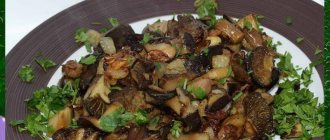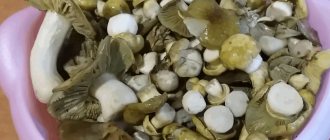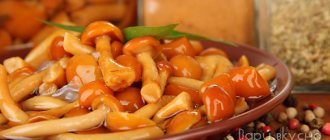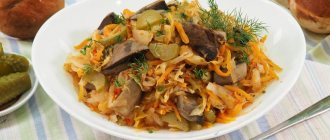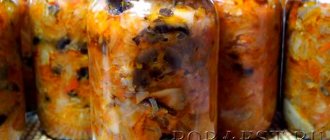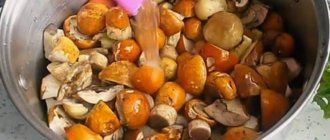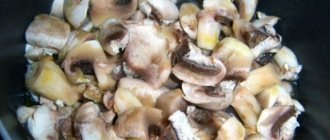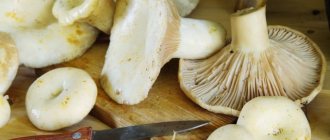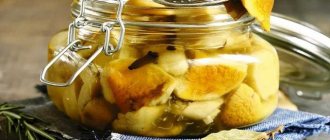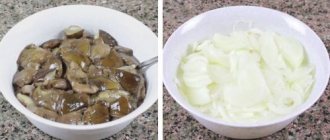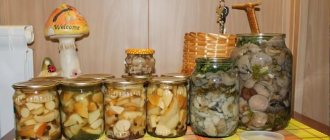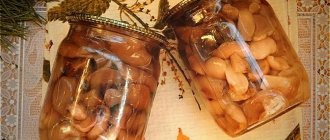2
Prepared by: Larisa Tryamkina
10/19/2021 Preparation time: 7 days. 22 hours 0 minutes
| Save | I cooked) | Estimate |
Everyone is used to the fact that greenfinches are salted and few people pickle them. But in fact, this mushroom is very tasty when pickled. Take it into service!
Primary preparation
Greenflowers grow mainly on sandy soils. The inner surface of the cap of this mushroom is lamellar; grains of sand are often buried deep inside. The rich marsh color of the fruiting body is preserved even after heat treatment. Intensely colored specimens are believed to retain small amounts of toxic substances. All harmful components are easily removed from the pulp during step-by-step primary preparation:
- Fruiting bodies are shaken off soil, leaves, needles and sandy residues.
- Soak in warm water for 30 minutes in a large container.
- Wash each specimen under cold running water.
Some housewives soak the rows in a saline solution. To do this, dissolve 2 glasses of salt in a bucket of water and place the rows there for an hour. During this time, the plates under the cap open well, and the sand sinks to the bottom. Afterwards, the fruiting bodies are thoroughly rinsed in clean water.
Attention! The skin of the cap of greenfinches is not removed. Dirt from the leg is scraped off with a knife or brush.
When to collect earrings and greenfinches. Similar mushrooms and false dangerous doubles
In terms of the structure of the fruiting body, the rows (including inedible and poisonous ones) are similar to each other.
Characteristic features are not always easy to identify, since mushrooms tend to change externally over time: in color, cap shape, stem structure. ATTENTION! One of the most reliable criteria for selecting edible mushrooms is smell. In dangerous twins, it is usually unpleasant (putrefactive or rotten eggs), while in edible rows it is light, reminiscent of the smell of flour or cucumbers.
Serushka can easily be confused with the following mushrooms:
- poisonous pointed rower (Tricholoma virgatum). Young mushrooms have a conical cap, which becomes flat as they grow, thinner than that of an edible mushroom. Characterized by a small tubercle in the center. Color - ash gray or earthy. The leg is thin. The plates are greyish. The pulp tastes hot.
- Soap mushroom (Tricholoma saponaceum) is an inedible mushroom with an olive-green or olive-brown cap. The color is uniform, without diverging stripes. It is quite easy to distinguish - there is a strong smell of laundry soap.
- The distinguished row (Tricholoma sejunctum), also known as the isolated row, has the status of conditionally edible. It has an unpleasant odor and bitter taste of the pulp. Requires long-term heat treatment before use.
REFERENCE! The color of the isolated row varies: from gray-brown to yellow-green or dark olive. Therefore, it can be mistaken for a greenfinch.
The green row has its dangerous counterparts. First of all, this is the sulfur or sulfur-yellow row (Tricholoma sulphureum). The poisonous mushroom is smaller in size, “frail” in structure: thin stem, sparsely spaced plates. The pulp is yellow, has an unpleasant odor and bitter taste. Trying to describe this aroma, some mushroom pickers compare it with tar, others with hydrogen sulfide.
Of the inedible mushrooms, the greenfinch is similar to the sultry row (Tricholoma aestuans) and the already mentioned isolated row. You can find out what the serushka and greenfinch mushrooms look like by carefully examining the photo.
Cold way
With the cold method of pickling mushrooms, the solution in the jar turns out to be transparent, but bland. The mushrooms are taken out of the jar and the marinade is decanted. The workpiece is transferred to a plate, vinegar, aromatic vegetable oil, and onions are added.
How to prepare pickled mushrooms using the cold method - description:
- The prepared rows are boiled for 30 minutes in water, to which salt and citric acid are added at the tip of a knife.
- The liquid is drained, the mushrooms are washed, and cooled to room temperature.
- Place the boiled pieces in clean sterilized jars and pour in cold marinade.
- Close the jars with nylon lids and place in the refrigerator for 15 days.
For the marinade take:
- water - 1 l;
- salt - 50 g;
- sugar - 30 g;
- vinegar - 250 ml;
- peppercorns - 5 pcs.;
- clove buds - 2 pcs.;
- caraway seeds - 5-6 pcs.
All dry ingredients are dissolved in boiling water, boiled for 2-3 minutes, vinegar is added.
Hot method
For 1 kg of mushrooms, about 300 ml of marinade is required.
Ingredients:
- water - 1 l;
- vinegar 9% - 200 ml;
- salt - 50 g;
- sugar - 25 g;
- allspice - 7-10 pcs.;
- clove buds 3-4 pcs.;
- bay leaf - 2 pcs.;
- dill umbrella - 1 pc.;
- currant leaves - 2 pcs.
How to roll green mushrooms:
- Boil 3 kg of prepared mushrooms in 10 liters of water for 5-10 minutes. Express.
- All ingredients for the marinade, except vinegar, are added to boiling water and the boiled rows are lowered.
- Boil them in brine for about 30 minutes on low heat, add vinegar and turn off.
- Pour the finished product into jars. For each liter jar add 1 tbsp. a spoonful of sunflower oil.
- Close the container with a nylon lid and put it away in the cold. After 5-7 days, the mushrooms are ready.
During the cooking process, the marinade becomes dark and viscous, but rich in taste. Before use, such mushrooms are washed with running water, sprinkled with vegetable oil, and onions are added if desired.
Canning
To cover greenfinches for the winter, you will need the following brine products:
- water - 1.5 l;
- salt - 75 g;
- sugar - 50 g;
- peppercorns - 7 pcs.;
- clove buds - 3 pcs.;
- caraway seeds - 6-7 pcs.
Bring the water to a boil, add salt, sugar, spices and boil for 2-3 minutes.
Cooking steps:
- The mushroom pulp is blanched for 5-7 minutes in boiling water and cooled under running water.
- The fruiting bodies are laid out in jars, not reaching 2 cm to the top.
- Pour in the prepared brine and add 2 tbsp. spoons of vinegar into each jar.
- Cover the jars with tin lids, but do not screw them on.
Full jars are sterilized according to the time: 0.5 liters are boiled for 10 minutes, liter jars - 15 minutes, 2 liter jars - 20 minutes. Green mushrooms prepared using this method should be covered with iron lids and stored in the cellar.
The benefits and harms of gray and green rowing
Of primary importance is the high content in mushrooms of the building material of the entire human body - proteins. In this regard, mushrooms can easily replace meat, which makes them indispensable in vegetarian diets and during religious fasting.
Of the other valuable elements that determine the nutritional value of gray and green rows, it should be noted:
- vitamins B1 (thiamine), B2 (riboflavin) and B5 (pantothenic acid), which are involved in carbohydrate metabolism and have a beneficial effect on the nervous and cardiovascular systems;
- vitamin PP - nicotinic acid, which speeds up metabolism, releasing energy from carbohydrates, proteins and fats;
- vitamin A (carotene) is a natural antioxidant responsible for the regeneration of damaged cells, affecting the condition of the skin, hair and visual acuity;
- vitamin D, necessary for the absorption of calcium;
- copper, involved in the synthesis of hemoglobin, collagen, elastin and the hormone endorphin;
- zinc is a trace element that allows you to regulate blood sugar levels, necessary for strong bones, beautiful hair and nails;
- manganese, which is involved in the regulation of glucose, cholesterol, promotes the growth of connective tissues, etc.;
- phosphorus, necessary for strong teeth and bones.
Thanks to this composition, rows have antibacterial, antiviral and antioxidant properties, help fight inflammation and can strengthen the immune system.
Mushrooms are recommended for patients with diabetes and arterial hypertension. Another useful property is a calming effect, normalizing the functioning of the nervous system after overwork.
ATTENTION! Only mushrooms collected in ecologically clean areas can bring benefits. Quiet hunting along roads, near industrial enterprises, and landfills is dangerous because toxins accumulate in the fruiting bodies, which persist even after cooking and poison the human body.
Meanwhile, mushrooms are quite difficult food to digest and can cause an allergic reaction. To avoid unwanted consequences, it is not recommended to consume mushrooms for the following people:
- under 10 years of age;
- suffering from any gastrointestinal diseases (gastritis, ulcers, colitis, irritable bowel syndrome, etc.);
- having individual intolerance to the product.
The danger may be the content of green anticoagulants in the row - substances that prevent the formation of blood clots. Therefore, greenfinch is contraindicated in the following conditions:
- peptic ulcer and kidney stone disease;
- liver diseases;
- bleeding tendency (hemophilia);
- pregnancy.
REFERENCE! There are studies that have shown that the toxins contained in greenfinch can affect skeletal muscles and cause acute rhabdomyolysis (muscle necrosis and kidney failure).
Cold salting
Those who are opposed to drinking vinegar can pickle mushrooms for the winter without using brine. Rows prepared using this method are ready for consumption after ripening. The process takes about 1.5 months. Salted mushrooms are stored at a temperature of +5+6°C. If the temperature is higher, they will acidify and become moldy; if the temperature is lower, the pickling process will slow down, the mushrooms will become slimy and tasteless.
Ingredients:
- prepared mushrooms - 2 kg;
- table salt, non-iodized - 70 g;
- fresh dill branches - 100 g;
- peppercorns - 20 pcs.
How to prepare pickled greenberries:
- The washed rows are placed in a colander and blanched in boiling water for 5 minutes.
- The fruits are cooled under running cold water, and the water is allowed to drain.
- Place the row in layers in jars and sprinkle with salt.
- Chopped dill and spices are placed on top.
- Cover with a nylon lid and put away for storage.
Preliminary preparation at home
As a rule, the preparatory stage before pickling mushrooms is a complex, long process that requires patience. It includes sorting (if you collected different types of mushrooms, and not just green stuff), clearing forest debris and washing.
- Sorting. It is better to divide all collected mushrooms by type. This is due to the fact that the time required for salting may differ for different types of fruiting bodies.
- Cleansing. The greenfinches are freed from dirt and the damaged areas are cut out with a knife. Cleaned mushrooms are washed in cold water. Don’t forget to thoroughly wash the middle recesses of the caps, as hard-to-reach dirt and debris accumulate there.
Green mushrooms are not a very popular mushroom among people, and it is completely in vain that many lovers of quiet hunting underestimate them. Find out how to properly pickle green vegetables for the winter and what products you will need for this. How to store the preparations and what to do to make the pickles delight guests and household members for a long time.
Greenfinches are very common mushrooms with a dubious reputation. Despite the general opinion about their toxicity and frequent cases of poisoning, these forest trophies remain a favorite dish in many Russian families. It is believed that properly prepared green row can do no harm, but it will certainly provide gastronomic pleasure. Let's look at the most popular recipes for salting and marinating them.
Ingredients
Preservation of salted greens without sterilization
Mushrooms are salted in a large enamel or wooden container. For pickling, take raw greenfinches, which are pre-soaked in water for 5-6 hours. The water is changed every hour. Mushrooms are salted according to strict rules:
- Currant leaves and dill umbrellas are washed and doused with boiling water.
- Mushrooms, salt, aromatic leaves and dill are placed in layers at the bottom of the barrel.
- Fill with chilled brine at the rate of 30 g of salt per 3 liters of water.
- Place a gauze napkin on top and cover with a wooden circle or plate.
- They put oppression - a stone or a jar of water. Store at a temperature of +5+6°C in a dark place.
- As the liquid evaporates, a new brine solution is added so that the caps are completely covered with water.
If mold appears on the surface, the top layer of mushrooms is removed and discarded. The circle and gauze are washed and scalded with boiling water. A new solution is added to the container and a clean oppression is placed.
Differences between an edible mushroom and a toadstool
This mushroom can be distinguished from its inedible “twin”, the gray-yellow row, by the following characteristic features: the greenfinch’s cap grows up to 15 cm in diameter and has a convex tubercle in the center; on the inside of the cap, densely spaced light yellow plates are visible, emitting a specific “floury” smell. The mushroom stalk is usually short, reaching 2-3 cm, elastic and dense in structure. The color of the leg has a greenish or yellowish tint. The flesh of the mushroom is white and turns yellow over time, which indicates that the greenfinch may contain toxins. In this article we will tell you how to pickle greenfinches, how to pickle and process them. The main thing is to be careful and remember that consuming this mushroom in large quantities can be dangerous.
Drying
Young and mature greenfinches are suitable for drying. Before drying, they are soaked in the usual way for about 10 minutes to remove sand from the plates. Then the mushrooms are washed and dried in several ways:
- in the microwave in small batches;
- in an electric dryer without outside control;
- in the oven under constant supervision.
The most affordable option is to dry the rows naturally. To do this, the pieces are strung on a thread loosely to each other. The garlands are placed in a dry, warm, well-ventilated room. If moisture gets on the mushrooms, they are urgently dried in the oven at a temperature of 90-95°C. Do not allow overdrying or burning.
Cooking secrets
Iodized or “Extra” salt is not suitable for salting mushrooms. Choose coarse sea or table salt.
You should not use galvanized or glazed utensils to cook mushrooms, otherwise a chemical reaction may occur and the product will be spoiled.
If you approach the pickling process wisely, then greens will become an excellent delicacy and decoration for your holiday table. Don’t forget to clean the mushrooms well so that all harmful substances are removed from the rows, and then the dish will delight you with its taste and benefits.
Freezing
Greenfinches tolerate storage well in the freezer. Freezing is carried out in 2 ways:
- Prepared and boiled mushrooms are cut into small pieces and sent into bags in portions. In winter, they are taken out, doused with boiling water and immediately added to soups and salads. The shelf life of boiled rows in bags is 4-5 months.
- Raw prepared mushrooms are packaged whole in small bags. This type of workpiece is more suitable for frying as a whole. Raw frozen pulp is suitable for consumption for 6-9 months.
Attention! Mushrooms cannot be re-frozen, so they are packaged in small portions of 300-500 g.
Cold pickled mushrooms without vinegar
Pickled mushrooms are much healthier than pickled ones. With this method of preparation, all the useful substances are preserved in them. The absence of vinegar makes them suitable for consumption by people with kidney and gastrointestinal problems. During the process of lactic acid fermentation, the chitin in the mushrooms dissolves naturally, which makes their taste deliciously delicate. There is no particular difference between pickling and pickling mushrooms in a cold way, but there is a fundamental difference. For 1 kg of mushrooms, take 80 g of salt and 30 g of salt to create a nutrient medium for lactic acid bacteria.
Attention! Due to the content of toxic substances in green mushrooms, only boiled young mushrooms are suitable for pickling.
You will need:
- boiled warm rows - 3 kg;
- salt - 80 g;
- sugar - 30 g;
- peppercorns - 10 pcs.;
- cilantro seeds - 10 pcs.;
- horseradish root - 3 pcs.;
- dill umbrellas - 3 pcs.;
- currant leaves - 10 pcs.;
- garlic - 2 heads;
- celery roots and petioles - 100 g.
You need to ferment the row like this:
- Warm boiled pulp is mixed with sugar and salt in a bowl.
- Place the greenfinch with its caps down on the bottom of an enamel pan.
- Seasonings and leaves are placed between the rows.
- The last layer is covered with currant leaves and covered with clean gauze.
- They put oppression on top and weigh it down with a load.
- Mushrooms are fermented for a week at a temperature of +15+20°C.
- After a week, put them in clean jars and put them in the refrigerator.
No additional liquid is needed for fermentation. There is already enough moisture in boiled mushrooms; it will come out under pressure.
Serushka and greenfinch mushrooms. Greenfinch.
Among the many types of rows (and there are, according to various estimates, from 20 to 25 thousand!) the green row takes a special place. She has many fans among mushroom pickers. They collect it, do not avoid it, and in a number of regions, if the mushroom season is not successful, then they specially go for it.
The advantage to all this is that it appears relatively late and does not enter into direct competition with many types of mushrooms. And the fact that it can grow even before severe frosts, easily tolerating small frosts, is a big plus for it.
In addition, mushroom pickers can evaluate their reserves for the winter and additionally collect just that, since at the end of September and until the end of October, there are not so many mushrooms left in our forests.
GREEN ROW (Tricholoma Equestre).
It is also called greenfly, greenback, sandstone, greenfly, green sandpiper.
By the way:
For many decades now, there has been debate among scientists about whether greenfinch is an edible mushroom or not. Most scientific sources agree that this mushroom should be classified as conditionally edible.
WHAT IT LOOKS LIKE:
- Cap: up to 15 cm, fleshy, dense, colored in yellow-olive or greenish-yellow tones (or yellow-green, as you wish), and sometimes there are brownish inclusions in its center. The smooth cap of this mushroom becomes sticky in wet weather, so various forest litter and dust stick very strongly to it.
- Plates: thin, dense, greenish-yellow or yellow in color.
- Leg: up to 6 cm in length, it is slightly lighter than the cap, and below, near the ground, it can be covered with brown scales (but not always).
- The pulp is white (often turns yellow over time), which does not change color when cut or broken. The smell of greenfinch baffles those trying to identify it.
- To some, it reminds them of the smell of flour (I would like to ask them: rye or wheat? Or maybe buckwheat?) To others, including me, it reminds me of the smell of fresh cucumbers. At the same time, the smell is stronger, for some reason, in mushrooms that grow not far from the pine tree. I don't know if there is any explanation for this.
WHERE IT GROWS:
Greenfinches can grow in both deciduous and coniferous or mixed forests; more often they are found in sparse pine forests growing on light sandy soils.
You need to collect these mushrooms very carefully, otherwise you can bring home a bunch of sand, dry soil and other debris with them. They should be held vertically at the time of cutting, and the base of the stem with dried soil should be cut off immediately.
Not all mushroom pickers and not all regions take up the culinary processing of greenfinches, because they know little about this mushroom. Although, those who have been collecting, collecting and will continue to collect these mushrooms for years will not agree with this statement.
EDIBILITY:
Greenfinch mushrooms are considered conditionally edible. They are classified as category 4. First, the mushrooms should be boiled for 15 minutes until they settle to the bottom.
Supporters of greenfinches find high taste qualities in them, actively collect them and use them, both salted or pickled, and stewed or dried. When dried, the taste of greenberries noticeably intensifies, and when cooked, its color becomes more intense. Before processing, these mushrooms must be thoroughly washed (which takes a lot of time) and the skins removed from their caps.
THANK YOU TO EVERYONE WHO READ!
Fried greenberries in glass jars
Fried rows prepared for the winter are stored for no more than 3-4 months, but have an excellent taste. For frying, choose young, dense mushrooms. They are washed, cleaned and fried in a frying pan with sunflower oil. During the frying process, salt and pepper a little; no other spices are added. Fried warm mushrooms are transferred to clean hot jars and sterilized:
- 0.5 l - 20 minutes;
- 1 l - 35 minutes.
Roll up with tin lids and wrap in a blanket until it cools down.
Useful properties and calorie content
The green row contains amino acids, fatty substances, and carbohydrates, which are almost 100% absorbed by the body. Protein digestibility is up to 80%. Vitamins of group B, PP, and phosphorus are of considerable value. The calorie content of green row is only 22 kcal per 100 grams of product.
Important! Too many eaten rows can lead to poisoning. Also, people with reduced blood clotting should not eat greenberries.
A simple recipe for caviar for the winter
Fragrant, spicy mushroom caviar is a tasty and satisfying appetizer. Roll the workpiece into 0.5 liter jars.
Ingredients:
- cleaned rows - 2 kg;
- vegetable oil - 100 g;
- onions - 3 pcs.;
- carrots - 3-4 pcs.;
- salt - 1 tsp;
- ground pepper - on the tip of a knife;
- bay leaf - 1 pc.;
- vinegar 9% - 2 tbsp. spoons.
How to prepare caviar:
- Prepared mushrooms are boiled in salted water for about 10 minutes, washed, cut into small pieces or twisted in a meat grinder.
- Finely chop the onion and grate the carrots. Vegetables need to be fried in vegetable oil, then add mushroom mass and spices.
- Simmer the mixture for 1.5 hours over low heat.
- Add vinegar and roll into jars while hot.
Storage rules
The shelf life of canned greenfinches in a jar should not exceed 12 months, provided the jars are kept in a cold, dark cellar at a temperature no higher than +5+8°C. Homemade mushroom preparations are at risk of developing botulism. It is strictly forbidden to eat canned greenfinches if the tin lid is swollen.
It is better to eat pickled greenfinches under a nylon lid within 30-45 days. Store the preparations exclusively in the refrigerator.
Dried rows are placed in dry, clean jars, covered with a nylon lid or stored in linen bags, preventing moisture from entering and the accumulation of dampness.
Secrets, spices, additives...
Mushrooms do not “love” all spices. Dry dill umbrellas, currant leaves, peeled cloves of vigorous winter garlic, and horseradish root will help highlight the taste of greenfinch. Some housewives salt the rows in a pan with walnut leaves. They give mushrooms a specific taste and color.
Chefs have their own secrets for preparing delicious greens. Add to dishes:
- when marinating - allspice and black peppercorns, garlic, dill, rosemary, bay leaf;
- for frying - parsley, onion, dill, nutmeg, Provençal herbs;
- for making sauces - thyme, rosemary, ground black pepper.
In order for the mushrooms in jars to be crispy and elastic, you need to select only young specimens, up to 5 cm in height. During cooking, they are immediately immersed in boiling water and cooled sharply.
Greenfinch is a universal mushroom. It is suitable for drying, freezing, pickling, making soups and as a side dish. A properly prepared row will be an excellent addition to a meager diet and a delicious decoration for the New Year's table.
Greenfinch and silver mushrooms. Description of the golden row
The row has a dense fleshy cap of yellow, green or yellowish-olive color with a diameter of 4 to 12 cm. In young plants it is flat-convex with a tubercle on top, in mature plants it is spread out with raised, slightly wavy edges. Upon reaching adulthood, the cap darkens. The skin is thick, smooth to the touch, in rainy weather it becomes slimy and covered with soil particles and adherent leaves. This is due to the fact that the cap has small scales to which foreign bodies stick.
On the reverse side, the cap has frequent and thin plates 5-12 mm wide, lemon-yellow, sometimes greenish-yellow. When broken, the flesh is dense and white. The mushroom is less susceptible to infection than other brethren, and is practically never wormy. If you make a cut, the color on it does not change. When inhaled, the odor has a floury tint and an unexpressed taste. Experienced mushroom pickers note that the most pronounced smell is characteristic of rows that grew in a pine forest.
Greenfinch (greenfinch or golden rower) belongs to the rower family and belongs to the genus Lamelidae
If you pay attention to the leg, it is short and thickened towards the bottom, completely hidden in the ground. The color is yellow or yellow-green, depending on the age of the fungus.
Can't put on your favorite shoes?
Having a whole closet of so much beloved shoes, you have to walk around in shapeless moccasins and trampled ballet flats. And it's all about the protruding bones on the feet, which bring simply unbearable pain in general in any shoes. If you wear slightly thicker shoes than moccasins, one size too large, the inflammation will last for several more days. How to deal with bunions, read our material.
Collecting greenfinches brings additional trouble to mushroom pickers. Hidden prey must be found, properly cut, and then cleaned of sand and leaves before placing in the basket.
The green grass often grows on the sides of forest roads and is hidden under fallen leaves so that the cap is barely visible. Sometimes you can find a single specimen, but most often in a group. You can immediately find graylings and greenfinches together, which makes the collection even more enjoyable. Greenfinch has doubles, rows similar to her. You can distinguish them by their unpleasant smell. They are a little smaller and not as meaty. Often young mushroom pickers do not collect young green stuff because they are afraid of confusing it with toadstool. Externally, the difference is visible both in color and structure.
Its poisonous counterpart has a ring on the stem and the flesh is not so elastic.
